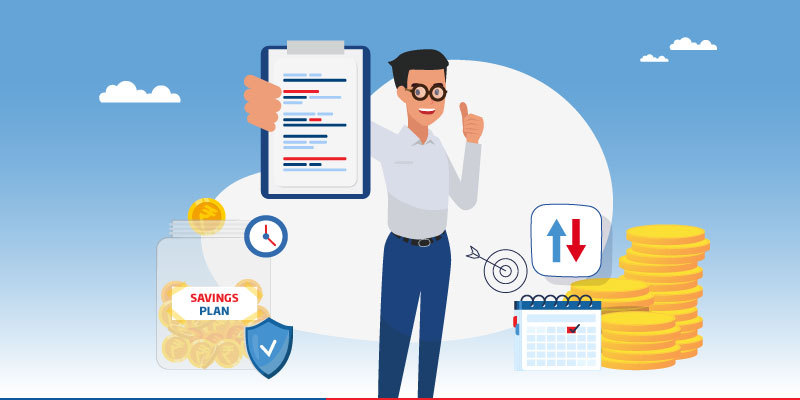What do you want to do?
Understanding differences between Investment & Savings Plans

Table of Content
What is a Savings Plan?
A savings plan entails setting aside funds for use later without fearing capital erosion. With easy accessibility, Financial security through savings prepares you to handle unforeseen expenses like medical emergencies, repairs to a car, loss of income, etc., that crop up anytime in life.
Though savings plan returns are much lower than investments, the risk involved is very low. Compound interest in savings in high-yield savings accounts like fixed deposits yields higher returns, and you can choose to park your funds in these deposits.
What is an Investment Plan?
An investment plan is acquiring assets for your money to work for you and eventually create wealth. The investment intends to earn returns and create a corpus to fulfil your short-term and long-term financial goals. The various long term investment tools available in the market are stocks, mutual funds, exchange-traded funds, bonds, pension plans, etc. You can choose to invest in a short term investment plan like fixed deposits for short-term goals like planning a vacation, downpayment for a car, etc.
Earlier, investment was possible only in gold or real estate and huge resources were needed. Today, with different types of investments (stocks, bonds, mutual funds) available, you can commence your investment journey with a small amount. However, you need to understand how and where to invest to maximise your wealth.
If you are a novice in the investment field, seek the advice of a financial advisor to understand how and when to invest, factors to consider, and which assets work for you considering your budget, risk tolerance and goals.
Savings Vs Investment Difference
Though savings and investment are used interchangeably in a discussion, they are not the same. The table below gives insight into the saving and investment difference.
Features |
Savings |
Investment |
Objective |
Emergency fund and short-term financial goals. |
Wealth accumulation over time and growth. |
Investment duration |
For a short term with easy liquidity. |
For a long term with a lock-in period. |
Risk Exposure |
Low-risk |
Varies between low to high risk. |
ROI |
Lower than market-related assets but guaranteed. |
Higher returns. Depends on the growth potential of investments. Fluctuating and not guaranteed. |
Accessibility |
High liquidity. |
Low liquidity. Incurs penalty for premature withdrawal. |
Purpose of Gains |
Capital protection with lower returns. |
Varying risk levels. The rate of returns depends on market trends. |
Tax Implications |
The interest earned is taxable. |
Depending on the asset chosen and the territory. |
Emergency Fund |
A tool to build emergency funds. |
Not suitable for short-term goals. Emphasises more on long-term goals. |
Pros and Cons of Savings
When it comes to liquid vs. illiquid assets, savings are a better option, though the returns are much lower. Furthermore, it is a safe bet for those with low-risk tolerance as there is no fear of losing cash. It is simpler to park funds in a savings plan and easily available in times of need.
Some of the advantages of savings are:
- The returns are predictable as the rate of interest is specified upfront.
- Your capital is protected, especially when the savings are within the limits eligible for insurance coverage.
- Easily accessible in case of need.
- The only money you tend to lose are the maintenance charges and penalties for violation of guidelines.
- Savings is a simple process and does not involve any upfront charges.
However, there are some disadvantages too, like:
- The returns are much lower compared to investment.
- The returns do not beat inflation, and investment value will deplete over time.
Pros and Cons of Investment
Given a choice of saving vs. investing, individuals with a high-risk appetite choose to invest, though savings are a safer bet.
The advantages of investment are:
- The returns are much higher compared to savings.
- Investment products like stocks, ETFs, etc., are highly liquid. You can sell and convert to cash anytime you need funds.
- With a diversified portfolio, you can balance risk with rewards and higher returns over time to beat inflation. The purchasing power diminishes over time if the returns do not keep up with the inflation rate.
The disadvantages of investment are:
- The returns are fluctuating and depend on market performance. Without a diversified investment plan, you tend to lose money.
- If you sell the assets when the market is low you may not recover your initial investment.
- If you aim at higher returns, you have to hold back the investments for longer periods, which means the funds are not easily accessible.
- Investment is a complicated process and needs extensive research to understand the performance of assets.
- Brokerage charges may be high.
How Much Should You Save or Invest?
How much you should save or invest depends on your financial goals and your budget. Some groundwork, as given below, is necessary to understand the extent of saving or investment you require.
Write Down Your Goals
Jot down your financial goals. Give a time horizon for these goals and arrange them in the order of priority. Evaluate the amount you need within the period to achieve these goals and plan to save or invest accordingly.
Assess Your Income
Assess your income and expenses and check if there is room to save or invest for these financial goals. If not, categorise the expenses as needs and wants and strike off the wants if they do not matter to enhance the surplus or look for passive income opportunities to enhance the surplus.
You can then evaluate emergency savings vs investment portfolio and allocate funds accordingly.
Factors to Consider in Choosing Between Saving and Investing
Knowledge about saving strategies vs investment strategies is crucial before you commence either savings or investment. In addition, awareness about the factors to consider when choosing between saving and investing helps in making informed decisions and strengthening your financial resilience. The key factors that impact your decision are:
Financial Goals
Make a list of your short-term and long-term financial goals. Have a mix of savings and investment. Allocate funds to a savings plan for short-term goals and choose investments for long-term goals.
Liquidity
If you need easy access to funds, then choose to park funds in a savings plan. Investment in assets has a lock-in period during which liquidation becomes difficult.
Risk Tolerance
Risk-averse individuals who prioritise capital protection over returns should choose savings. Investment is associated with varied risk levels ranging from low to high. Risk assessment in investing is highly essential. Without a diverse investment plan, you may lose money when the market is low.
Duration
The length of time invested plays an important role in choosing between savings plans and investments. If you expect higher returns and intend to stay invested for longer periods, then investment is the one. If you need funds within 1 or 2 years, then savings should be your choice.
Wrapping It Up
Savings and investment have an important role to play in financial planning. Understanding the saving and investment difference is crucial to efficiently managing your finances. While savings offer high liquidity and equip you for short-term needs, investments help wealth creation. Though the returns are much higher in investments, the risk attached is also higher. Striking a balance between savings and investment is the motto for financial security.
FAQs on The Difference Between Investment and Savings
Q. What is the main difference between saving and investing?
Saving is allocating funds from your income for needs shortly without spending it immediately. It serves as a safety cushion for unforeseen expenses that arise in the future. Investments are allocating funds to assets that yield returns or income over time and have a risk component.
Q. When should I choose savings over investment?
If you feel that you need money soon, i.e., within a year or two, you should park it in a savings plan for easy access whenever necessary. Investments are a good option to earn returns if the time horizon for your goals is 5 years or later.
Q. How do risk levels differ between savings and investments?
The main difference between savings and investment is the risk levels. A savings plan, a low-risk option, may not fetch high returns, but there is no fear of losing value. However, there is a certain level of risk involved in investments ranging from low to high depending on the type of assets you invest in.
Q. What key characteristics differentiate savings from investments?
The key characteristics that differentiate savings from investments are the objective, duration, risk level, interest rates, and tax implications.
Q. How do returns differ between savings and investments?
The returns on savings are low but guaranteed with no risk involved. However, investments provide opportunities to earn higher returns but with an element of risk. The returns fluctuate according to market performance. You face the risk of losing investments, whereas your money is safe in savings.
Q. What factors should you consider when choosing between saving and investing?
The factors to consider when choosing between savings and investment are liquidity, risk tolerance, duration, financial goals, tax implications, and returns.
Related Articles:

Not sure which insurance to buy?
Talk to an
Advisor right away
Advisor right away

We help you to choose best insurance plan based on your needs
Here's all you should know about life insurance.
We help you to make informed insurance decisions for a lifetime.
HDFC Life
Reviewed by Life Insurance Experts
HDFC LIFE IS A TRUSTED LIFE INSURANCE PARTNER
We at HDFC Life are committed to offer innovative products and services that enable individuals live a ‘Life of Pride’. For over two decades we have been providing life insurance plans - protection, pension, savings, investment, annuity and health.

Popular Searches
- term insurance calculator
- Best Investment Plans
- Investment Calculator
- Investment for Beginners
- guaranteed returns plans
- Best Short Term Investments
- Best Long Term Investments
- 1 Crore Investment Plan
- 5 year Investment Plan
- 10 year Investment Plan
- 20 year Investment Plan
- Insurance vs. Investments
- savings plan
- ulip plan
- retirement plans
- health insurance plans
- child insurance plans
- Best Child Investment Plans
- group insurance plans
- personal accident insurance
- saral jeevan bima yojana
- income tax calculator
- bmi calculator
- compound interest calculator
- income tax slab
- Income Tax Return
- benefits of term insurance calculator
- what is term insurance
- why to invest in life insurance
- Ulip vs SIP
- tax planning for salaried employees
- how to choose best child insurance plan
- Retirement Planning
- 1 crore term insurance
- HRA Calculator
- Annuity From NPS
- Retirement Calculator
- Pension Calculator
- What is Investment
- ULIP Calculator
- nps vs ppf
- short term investment plans
- safest investment options
- one time investment plans
- types of investments
- best investment options
- best investment options in India
- Money Back Policy
- Zero Cost Term Insurance
- critical illness insurance
- Whole Life Insurance
- benefits of term insurance
- types of life insurance
- types of term insurance
- Endowment Policy
- Benefits of Life Insurance
- Term Insurance for NRI
- term insurance plan
- life insurance
- life insurance policy
This material has been prepared for information purposes only, should not be relied on for financial advice. You should consult your own financial consultant for any financial matters.
1. Provided all due premiums have been paid and the policy is in force.
18. Save 46,800 on taxes if the insurance premium amount is Rs.1.5 lakh per annum and you are a Regular Individual, Fall under 30% income tax slab having taxable income less than Rs. 50 lakh and Opt for Old tax regime.
ARN - MC/12/24/19441


